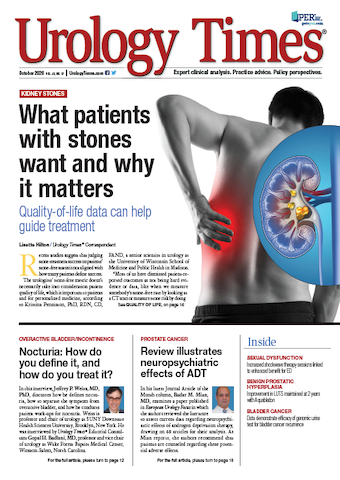Publication
Article
Urology Times Journal
Rapid advances propel prostate biopsy forward
Author(s):
Advanced imaging and improvements in biopsy techniques usher in a new paradigm for screening and diagnosis.
Over the past 10 years, there has been a rapid evolution in the evaluation and diagnosis of prostate cancer. Previously, prostate cancer detection relied on a digital rectal exam and systematic biopsy using transrectal ultrasound guidance. Improved prostate cancer detection was obtained by increasing the number of cores taken during the biopsy. However, advancements in prostate imaging with multiparametric magnetic resonance imaging (mpMRI) has changed the prostate imaging paradigm. Tumors that were previously only detected microscopically can be detected radiographically prior to biopsy. This has resulted in the adoption of image fusion technology to combine the MRI imaging with real-time ultrasound imaging during the prostate biopsy procedure.
Kelly L. Stratton, MD

Acknowledging the expanded role of prostate mpMRI in the detection and treatment of prostate cancer, the American Urological Association (AUA) provided a policy statement in 2017 regarding mpMRI.1 At the time the statement was published, there were sufficient data to support prostate MRI in patients with a prior negative biopsy and an ongoing concern for cancer. However, insufficient data were available to support routine prostate MRIs as preparation for a patient’s initial biopsy. New data evaluating mpMRI prior to biopsy have shown a potential benefit for patients undergoing their first biopsy. The AUA recently released an updated standard operating procedure (SOP) with a recommendation to consider mpMRI for all men with no prior biopsy who are considering a prostate biopsy.2 In this article, we will discuss the updated SOP for prostate imaging and consider additional recent reports on prostate biopsy in light of this rapidly changing field.
What constitutes optimal imaging?
The added value of prostate imaging is dependent on the combination of image quality, reader experience, and engagement from the urologist performing the biopsy. The AUA SOP suggests that optimal imaging is provided by a 3.0 Tesla (T) magnet with a surface coil. Some centers with older 1.5 T machines may obtain acceptable imaging using an endorectal coil, whereas those with newer 1.5 T scanners obtain adequate images without the coil. Both anatomical and functional images should be acquired, with target lesions identified and marked by the radiologist using the PI-RADS v2.1 criteria.

After identification of the potential target lesion, the urologist can determine the best approach to obtain adequate samples for diagnosis. Having the capability to conduct both transrectal and transperineal biopsy provides the best opportunity to sample the target regardless of location (Figure 1). Samples obtained during transrectal biopsy typically include a portion of both the peripheral zone and the transition zone. However, sampling apical areas of the prostate is more difficult from the transrectal approach, given the needle angle and potential for patient discomfort. Conversely, the transperineal biopsy provides cores with varying amounts of peripheral and transition zone, depending on the location of the biopsy. The needle orientation gives the advantage of obtaining cores from the apex of the prostate. In patients with a prior negative biopsy, apical lesions identified on mpMRI may be sampled using the transperineal approach to diagnose occult cancer that may have been missed on a prior transrectal biopsy (Figure 2).
The cases for, against systematic biopsy
Advancements in prostate cancer detection and opportunities for image-guided biopsy have resulted in some clinicians advocating against systematic biopsies as an unnecessary addition to the fusion-guided targeted biopsy. Arguments for avoiding systematic biopsy include a reduction in detecting clinically insignificant cancer and lessening the risk for adverse effects such as infection or bleeding. There might even be the potential to avoid biopsy altogether in patients who have no target lesion on the MRI.

However, a recent report from the TRIO study group cautioned against the omission of systematic biopsies.3 In this study, which included men who were biopsy naive, had a prior negative biopsy, and were on active surveillance, 2103 participants with an MRI-visible lesion underwent both systematic and targeted biopsy. Of those, 408 underwent prostatectomy. The investigators found that the combination of systematic and targeted biopsy resulted in the highest detection of clinically significant prostate cancer and prevented the misclassification of 8.8% of significant cancers missed on targeted biopsy alone. Further, when considering patients who went on to radical prostatectomy, the investigators found that the combination of systematic and targeted biopsy reduced pathologic upgrading to only 3.5% of patients.
Findings from additional retrospective studies have confirmed that detection of clinically significant cancer is optimized by the combination of systematic and targeted biopsies. In a study of over 500 patients with targetable lesions undergoing fusion biopsy, the detection of prostate cancer was significantly higher when combining systematic and fusion biopsy.4 When considering only those in whom clinically significant cancer was identified, the authors found that the combination of systematic and targeted biopsy resulted in a 6% improvement in cancer detection. Had the systematic biopsy been omitted, 29 of 185 patients (16%) with clinically significant cancer would have been misclassified. The authors concluded that standard systematic biopsy should be routinely included at the time of fusion biopsy to avoid missing a significant number of patients harboring occult clinically significant prostate cancer.
Alternative imaging modalities
Although MRI fusion biopsy has clearly been shown to improve prostate cancer detection, in some areas the implementation of prostate mpMRI has been hampered by the high costs of imaging systems and fusion devices. Many urologists can defray the financial burden by partnering with a hospital or imaging center. However, even when adequate imaging systems are in place, some urologists face a reluctance by radiologists to read mpMRI images and mark potential target lesions. The cost and complexities of mpMRI and fusion biopsy systems has led to the increased consideration of alternative imaging modalities. Advances in ultrasound technology have produced new, high-resolution micro-ultrasound devices capable of operating at much higher frequencies (29MHz) than standard ultrasound devices. This higher frequency provides significant improvement in ultrasound image resolution, with some devices achieving a resolution of up to 70 μm. The improved resolution means that micro-ultrasound is better able to visualize the ductal anatomy and cell density, which, like mpMRI, could represent changes associated with prostate cancer.5
A recent study compared the accuracy of micro-ultrasound directed prostate biopsy to MRI-fusion prostate biopsy.6 The study included 104 patients with known lesions on mpMRI who underwent a micro-ultrasound targeted biopsy followed by an MRI-fusion targeted and 12-core systematic biopsy. The micro-ultrasound targeted biopsy was found to have a sensitivity of 94% for the detection of clinically significant prostate cancer, with 33/35 cases successfully identified. The specificity of micro-ultrasound was 28% with a positive predictive value of 40%. There was general concordance of targets between micro-ultrasound and mpMRI lesions. However, micro-ultrasound detected clinically significant cancer in 3 discordant cases whereas mpMRI detected clinically significant cancer in 4 discordant cases. The authors concluded that advanced prostate ultrasound may provide a new option for the detection of clinically significant prostate cancer.
The last decade has seen a back-and-forth swing in enthusiasm for prostate cancer screening and diagnosis. The era of early detection with prostate-specific antigen (PSA) screening and aggressive treatment of low-risk disease ended with a movement recommending against PSA testing. However, some believe that the resulting wave of high-risk and advanced prostate cancer could be attributed to delays in diagnosis that developed from these recommendations. Advances in prostate imaging have provided a new opportunity to identify prostate cancer early on and provide effective treatment.
A fear that we may be repeating the past sins of overdiagnosis has started to gain momentum, but it is important to consider the alternative perspective. We know that, historically, prostate cancer was a frequent cause of cancer mortality in men. Although recent advances in the treatment of advanced prostate cancer have produced significant survival gains, improved detection could prevent the development of advanced disease while allowing for treatments that preserve quality of life. Advances in prostate imaging have led to the consideration of focal therapy for men with identifiable lesions who are willing to consider novel treatments that are less likely to cause changes in urinary and sexual function.
Conclusion
Advanced prostate imaging and improvements in prostate biopsy techniques have resulted in a new paradigm of prostate cancer screening and diagnosis. Men with elevated PSA are now considered for up-front prostate imaging with mpMRI. Those with no lesion undergo a 12-core systematic biopsy whereas those with a lesion undergo targeted sampling of the index lesion. Men with a negative biopsy have the assurance that occult clinically cancer is not present. Additional genomic testing is available based on the urologist’s preference. Men with low-risk disease can be offered active surveillance with a future confirmatory biopsy following a repeat MRI. The era of repeat serial biopsy has been replaced by prostate imaging. It is true that although image-guided prostate biopsy may increase the diagnosis of some low-risk cancers, it also provides improved opportunities for surveillance.
Unfortunately, some men will be diagnosed with clinically significant prostate cancer. For those with intermediate- and high-risk disease, prostate imaging can be useful for staging and treatment planning. This can be particularly helpful for the evaluation of nerve sparing and bladder neck anatomy. Although the potential impact of micro-ultrasound remains unknown, continued improvements in prostate imaging should further optimize prostate cancer detection, reduce treatment morbidity, and improve outcomes of prostate cancer treatment.
Stratton is assistant professor of urologic oncology at the University of Oklahoma, Oklahoma City.
References
1. Fulgham PF, Rukstalis DB, Turkbey IB, et al. AUA policy statement on the use of multiparametric magnetic resonance imaging in the diagnosis, staging and management of prostate cancer. J Urol. 2017;198(4):832-838. doi:10.1016/j.juro.2017.04.101
2. Bjurlin MA, Carroll PR, Eggener S, et al. Update of the standard operating procedure on the use of multiparametric magnetic resonance imaging for the diagnosis, staging and management of prostate cancer. J Urol. 2020;203(4):706-712. doi:10.1097/JU.0000000000000617
3. Ahdoot M, Wilbur AR, Reese SE, et al. MRI-targeted, systematic, and combined biopsy for prostate cancer diagnosis. N Engl J Med. 2020;382(10):917-928. doi:10.1056/NEJMoa1910038
4. Hanna N, Wszolek MF, Mojtahed A, et al. Multiparametric magnetic resonance imaging-ultrasound fusion biopsy improves but does not replace standard template biopsy for the detection of prostate cancer. J Urol. 2019;202(5):944-951. doi:10.1097/JU.0000000000000359
5. Laurence Klotz CM. Can high resolution micro-ultrasound replace MRI in the diagnosis of prostate cancer? Eur Urol Focus. 2020;6(2):419-423. doi:10.1016/j.euf.2019.11.006
6. Lughezzani G, Saita A, Lazzeri M, et al. Comparison of the diagnostic accuracy of micro-ultrasound and magnetic resonance imaging/ultrasound fusion targeted biopsies for the diagnosis of clinically significant prostate cancer. Eur Urol Oncol. 2019;2(3):329-332. doi:10.1016/j.euo.2018.10.001
























